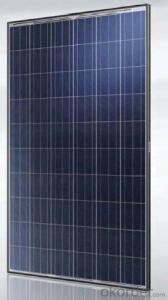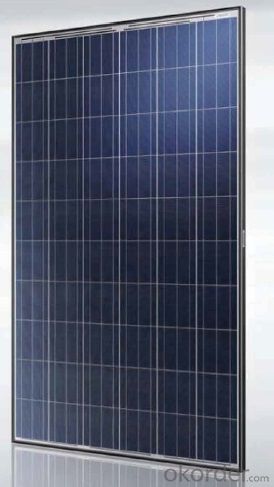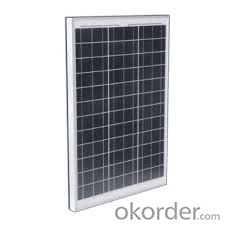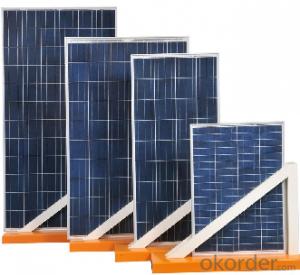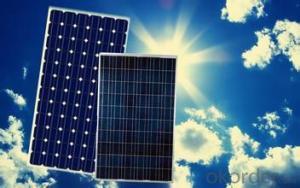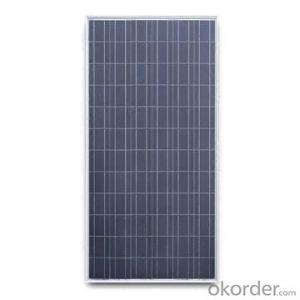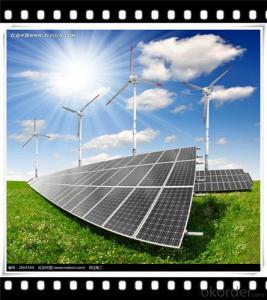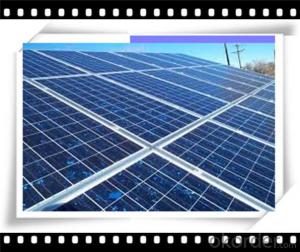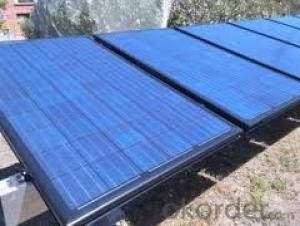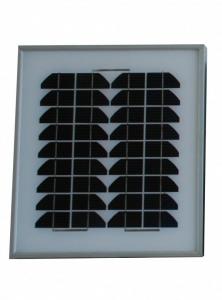65W Poly Solar Panel for Homeowner Solar Panels - CNBM
- Loading Port:
- Qingdao
- Payment Terms:
- TT OR LC
- Min Order Qty:
- 10 set
- Supply Capability:
- 300000 set/month
OKorder Service Pledge
OKorder Financial Service
You Might Also Like
Polycrystalline Solar Modules
CNBM offers a range of small, medium and large polycrystalline solar modules, designed for a range of requirements.
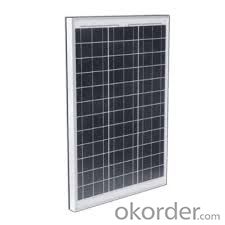
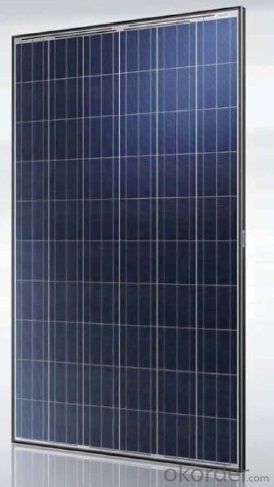
Specifications:
Tolerance | +/-3% |
Cell | Polycrystalline silicon solar cells (156 x 156mm) |
N0. of Cells | 60 (10 x 6) |
Dimension of Modules (mm) | 1650 x 990 x 40 |
Weight (kg) | 25.5 |
Limits:
Operating Temperature | -40~+85? |
Storage Temperature | -40~+85? |
Maximum System Voltage | 1000 VDC max. |
Hail Impact | Diameter of 28mm with impact speed |
Temperature and Coefficients:
NOCT | 48C+/-2? |
Voltage temperature coefficient (%/K) | -0.35 |
Current temperature coefficient (%/K) | 0.05 |
Power temperature coefficient (%/K) | -0.45 |
Characteristics:
Model: | SGM-200P | SGM-210P | SGM-220P |
Max-power voltage Vmp (V) | 29.2 | 29.4 | 29.41 |
Max-power current Imp (A) | 6.85 | 7.14 | 7.48 |
Open-circuit voltage Voc (V) | 36.5 | 36.69 | 36.9 |
Short-Circuit Current Isc (A) | 7.28 | 7.6 | 7.93 |
Max-power Pm(W) | 200 | 210 | 220 |
Model: | SGM-230P |
Max-power voltage Vmp (V) | 29.8 |
Max-power current Imp (A) | 7.72 |
Open-circuit voltage Voc (V) | 37.31 |
Short-Circuit Current Isc (A) | 8.19 |
Max-power Pm(W) | 230 |
STC: Irradiance 1000W/m2, module temperature 25?, AM-=1.5
Poly Crystalline Solar Panels Specifications Range
Maximum Power (Pm) | Dimension | Weight | Operating Voltage (Vmp) | Operating Current (Imp) | Open Circuit Voltage (Voc) | Short Circuit Current (Isc) |
0.45W | 140x80x10mm | 0.08kg | 3.3V | 150mA | 4.6V | 160mA |
1.0W | 162x140x10mm | 0.16kg | 7.5V | 150mA | 10.3V | 160mA |
4.5W | 269x251x23mm | 0.8kg | 16.5V | 0.27A | 20.5V | 0.3A |
10W | 420.1×268.9×22.6mm | 1.92kg | 17.5V | 0.58A | 20.5V | 0.6A |
20W | 425x502x50mm | 3.0kg | 16.8V | 1.19A | 21.0V | 1.29A |
30W | 593x502x22.6mm | 3.9kg | 16.8V | 1.78A | 21.0V | 1.94A |
40W | 655x537x50mm | 5.75kg | 17.3V | 2.31A | 22.1V | 2.54A |
50W | 839x537x50mm | 6.0kg | 17.5V | 2.9A | 21.8V | 3.17A |
65W | 1111x502x50mm | 7.2kg | 17.6V | 3.69A | 22.1V | 3.99A |
80W | 1204x537x50mm | 7.7kg | 17.6V | 4.55A | 22.1V | 4.8A |
- Q: What size of system would I need to get if I use on average 500 kilowatt hrs a month I would like to do a tie in grid system I live in the states south central area of States any info or links to sites would be wonderful I am interested in this type of energy soure thank you
- Create okorder /
- Q: Can solar panels be installed on a house with a flat roof?
- Yes, solar panels can be installed on a house with a flat roof.
- Q: My home uses an average of 2400 kW per month (28,800 per year.) How much can I expect it to cost to install solar panels of this amount? (It is not my intention to go off of the electric company's grid. I would like to generate what I can / possibly sell back extra power)What quot;hiddencosts are there? What is the average life of them?What is the quot;best(cost effective and green) solution / approach?(BTW.... I am in southern LA if that makes a difference)Best answer will go to clear answer WITH links/resources to back it up!)THANKS A MILLION!!! I hope you have a safe and happy holiday season!!!
- solar panels are expensive and you probably wont life long enough to recup the cost. last week the times quoted ?5000 to install, a potential saving of ?200 per year and 00 years to recoup. based on 400 hrs of sunshine. (uk) factor in your sunshine state hrs and you may just benefit.
- Q: How do solar panels affect the overall energy consumption of a building?
- Solar panels can significantly reduce the overall energy consumption of a building. By harnessing the sun's energy and converting it into electricity, solar panels provide a clean and renewable source of power. This reduces the reliance on traditional fossil fuel-based electricity, leading to lower energy bills and a reduced carbon footprint. Additionally, excess energy generated by the solar panels can be stored or fed back into the grid, further offsetting the building's energy consumption.
- Q: How do solar panels affect the overall comfort of a building?
- Solar panels can positively impact the overall comfort of a building by reducing energy costs and improving indoor temperature control. They generate clean and renewable electricity, which can power various systems such as heating, ventilation, and air conditioning (HVAC) units. This helps to regulate the indoor temperature more efficiently, leading to a more comfortable environment for occupants. Moreover, solar panels can also reduce reliance on the grid, ensuring a more reliable energy supply and enhancing the comfort and stability of the building.
- Q: Are there any government incentives or rebates for installing solar panels?
- Yes, there are various government incentives and rebates available for installing solar panels. These incentives can include federal tax credits, state and local rebates, grants, and loan programs. These incentives aim to promote renewable energy adoption, reduce carbon emissions, and make solar panel installations more affordable for homeowners and businesses. It is advisable to research and consult with local authorities or solar energy providers to determine the specific incentives available in your area.
- Q: I have 2 20 watt Solar panel. I have it hooked up to solar controller and batteries to inverter. Am trying to figure out how much watts am getting. I found the voltage but how do I find the amp reading on a mutimeter?
- It is possible your meter does not have the capacity to safely measure more than 300 milliamps which is too small to measure current output from solar panels. Assuming no losses in the system or components, if your meter does not have the capacity to measure 0 Amps, you will need to get one that does. Analogs are better than digitial for this. Most often the 0 Amp circuit of the meter has a discrete positive plug location for the positive test lead. Most have a common ground connection with the rest of the meter functions. If you are measuring current at the battery in the charge mode- Negative lead of meter goes to positive terminal of battery and positive lead of meter goes to the cable that was connected to the positive terminal of the battery. Since the Wattage is a nominal measurement, if you measure between the panel and controller, take measurement on one leg of the panel, as you want to measure the current with the loaded active circuit. Meter is oriented the same way as the measurement at the battery would be made above only this time the meter is between the panel and controller. At peak solar conditions, expect current to be measured at 2.5 to3 Amps or more per panel. Under optimal conditions your panel will have higher output than their ratings indicate. Open circuit can be close to 20 volts. Never short circuit the output of the solar panels. It is volts multiplied by amps that gives you Watts.
- Q: Are solar panels suitable for all climates?
- Solar panels can be suitable for a wide range of climates, but their efficiency may vary depending on factors such as sunlight intensity, temperature, and cloud cover. While solar panels can still generate electricity in cloudy or cold climates, they tend to perform best in regions with abundant sunlight. Advances in technology have made solar panels more adaptable and efficient in various conditions, making them a viable option for many different climates.
- Q: if i was to put a solar panel (sp) just outside of the earths atmosphere ans another solar panel (sp2) 0km away towards the sun. which one would generate more power (sp or sp2)? and how much more? is there a ratio to work out the power output and distance from the sun? would the 0km distance between the panels make a large difference in power output?many thanks in advance
- You do realize that the sun is 50 million km away don't you?
- Q: planning to get one, for a store/house, we use alot of electricity at least 500-3000 dollars a month. how much money would this save us? how big would we have to get the solar panel?[aproximately]
- Hi, One or two new windmills may not cost you as much I believe. Just my suggestion anyway.
Send your message to us
65W Poly Solar Panel for Homeowner Solar Panels - CNBM
- Loading Port:
- Qingdao
- Payment Terms:
- TT OR LC
- Min Order Qty:
- 10 set
- Supply Capability:
- 300000 set/month
OKorder Service Pledge
OKorder Financial Service
Similar products
Hot products
Hot Searches
Related keywords
